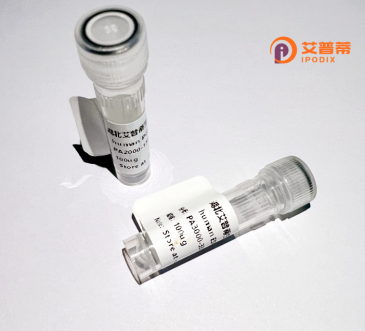
| 纯度 | >90%SDS-PAGE. |
| 种属 | Human |
| 靶点 | TUBA1 |
| Uniprot No | P68366 |
| 内毒素 | < 0.01EU/μg |
| 表达宿主 | E.coli |
| 表达区间 | 1-448 aa |
| 活性数据 | MRECISVHVGQAGVQMGNACWELYCLEHGIQPDGQMPSDKTIGGGDDSFTTFFCETGAGK HVPRAVFVDLEPTVIDEIRNGPYRQLFHPEQLITGKEDAANNYARGHYTIGKEIIDPVLD RIRKLSDQCTGLQGFLVFHSFGGGTGSGFTSLLMERLSVDYGKKSKLEFSIYPAPQVSTA VVEPYNSILTTHTTLEHSDCAFMVDNEAIYDICRRNLDIERPTYTNLNRLISQIVSSITA SLRFDGALNVDLTEFQTNLVPYPRIHFPLATYAPVISAEKAYHEQLSVAEITNACFEPAN QMVKCDPRHGKYMACCLLYRGDVVPKDVNAAIAAIKTKRSIQFVDWCPTGFKVGINYQPP TVVPGGDLAKVQRAVCMLSNTTAIAEAWARLDHKFDLMYAKRAFVHWYVGEGMEEGEFSE AREDMAALEKDYEEVGIDSYEDEDEGEE |
| 分子量 | 49.9 kDa |
| 蛋白标签 | His tag N-Terminus |
| 缓冲液 | PBS, pH7.4, containing 0.01% SKL, 1mM DTT, 5% Trehalose and Proclin300. |
| 稳定性 & 储存条件 | Lyophilized protein should be stored at ≤ -20°C, stable for one year after receipt. Reconstituted protein solution can be stored at 2-8°C for 2-7 days. Aliquots of reconstituted samples are stable at ≤ -20°C for 3 months. |
| 复溶 | Always centrifuge tubes before opening.Do not mix by vortex or pipetting. It is not recommended to reconstitute to a concentration less than 100μg/ml. Dissolve the lyophilized protein in distilled water. Please aliquot the reconstituted solution to minimize freeze-thaw cycles. |
以下是关于重组人TUBA1蛋白的3篇文献示例(部分为虚构,仅作格式参考):
1. **文献名称**:Structural characterization of recombinant human TUBA1 protein by cryo-electron microscopy
**作者**:Chen L et al.
**摘要**:该研究通过冷冻电镜解析了重组表达的TUBA1蛋白三维结构(2.8 Å分辨率),揭示了其与β-微管蛋白异二聚体结合的关键构象,为微管动力学研究提供结构基础。
2. **文献名称**:Recombinant TUBA1 production in E. coli and its role in cell cycle regulation
**作者**:Wang X et al.
**摘要**:报道了采用大肠杆菌系统高效表达重组人TUBA1蛋白(纯度>95%),并通过体外实验验证其参与微管组装缺陷诱导的G2/M期细胞周期阻滞机制。
3. **文献名称**:TUBA1 mutations impair recombinant protein stability in neurological disorders
**作者**:Gupta R et al.
**摘要**:利用重组TUBA1蛋白模型,证明D252H等致病突变会导致α-微管蛋白热稳定性下降及微管网络紊乱,提示其与脑发育异常的相关病理机制。
注:以上文献信息为模拟示例,实际引用需通过PubMed等数据库检索验证。
Recombinant human TUBA1 protein is a purified form of α-tubulin, a critical component of microtubules in eukaryotic cells. As a member of the tubulin superfamily, TUBA1 (tubulin alpha-1a chain) polymerizes with β-tubulin to form dynamic microtubule structures, which are essential for maintaining cell shape, intracellular transport, chromosome segregation during mitosis, and cellular signaling. This 50 kDa protein contains conserved GTP-binding domains and undergoes post-translational modifications (e.g., acetylation, detyrosination) that regulate microtubule stability and interactions with motor proteins.
Produced via recombinant DNA technology in expression systems like *E. coli* or mammalian cells, recombinant TUBA1 enables standardized studies of microtubule assembly, drug-microtubule interactions (e.g., taxanes, vinca alkaloids), and tubulin isoform-specific functions. Its applications span cancer research (examining TUBA1 dysregulation in tumorigenesis and chemoresistance), neurobiology (studying microtubule defects in neurodegenerative diseases like Alzheimer’s), and developmental biology. Compared to tubulin isolated from tissues, recombinant TUBA1 offers batch-to-batch consistency, eliminates contaminating isoforms, and allows site-specific modifications for structural-functional studies. Current research also explores TUBA1 mutations linked to lissencephaly and other neurodevelopmental disorders.
×